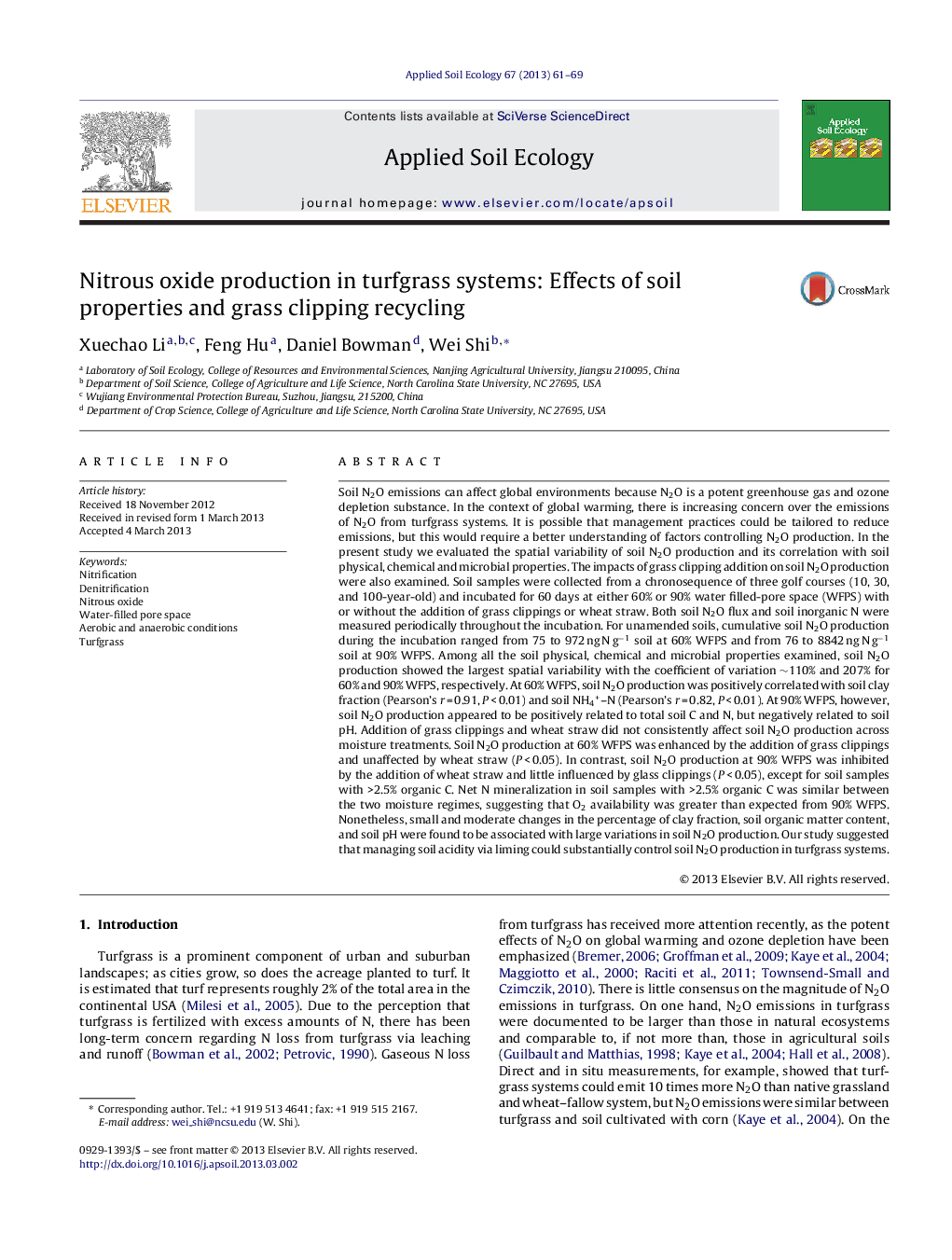| کد مقاله | کد نشریه | سال انتشار | مقاله انگلیسی | نسخه تمام متن |
|---|---|---|---|---|
| 4382553 | 1617816 | 2013 | 9 صفحه PDF | دانلود رایگان |

• Soil N2O production showed great spatial variability in turfgrass systems.
• Spatial variation in soil N2O production was more pronounced at higher soil moisture.
• Soil N2O production was correlated with soil clay fraction, organic matter or pH.
• Addition of grass clippings stimulated soil N2O production under aerobic conditions.
• Inhibitory effect was more likely under O2-limited conditions after clipping addition.
Soil N2O emissions can affect global environments because N2O is a potent greenhouse gas and ozone depletion substance. In the context of global warming, there is increasing concern over the emissions of N2O from turfgrass systems. It is possible that management practices could be tailored to reduce emissions, but this would require a better understanding of factors controlling N2O production. In the present study we evaluated the spatial variability of soil N2O production and its correlation with soil physical, chemical and microbial properties. The impacts of grass clipping addition on soil N2O production were also examined. Soil samples were collected from a chronosequence of three golf courses (10, 30, and 100-year-old) and incubated for 60 days at either 60% or 90% water filled-pore space (WFPS) with or without the addition of grass clippings or wheat straw. Both soil N2O flux and soil inorganic N were measured periodically throughout the incubation. For unamended soils, cumulative soil N2O production during the incubation ranged from 75 to 972 ng N g−1 soil at 60% WFPS and from 76 to 8842 ng N g−1 soil at 90% WFPS. Among all the soil physical, chemical and microbial properties examined, soil N2O production showed the largest spatial variability with the coefficient of variation ~110% and 207% for 60% and 90% WFPS, respectively. At 60% WFPS, soil N2O production was positively correlated with soil clay fraction (Pearson's r = 0.91, P < 0.01) and soil NH4+–N (Pearson's r = 0.82, P < 0.01). At 90% WFPS, however, soil N2O production appeared to be positively related to total soil C and N, but negatively related to soil pH. Addition of grass clippings and wheat straw did not consistently affect soil N2O production across moisture treatments. Soil N2O production at 60% WFPS was enhanced by the addition of grass clippings and unaffected by wheat straw (P < 0.05). In contrast, soil N2O production at 90% WFPS was inhibited by the addition of wheat straw and little influenced by glass clippings (P < 0.05), except for soil samples with >2.5% organic C. Net N mineralization in soil samples with >2.5% organic C was similar between the two moisture regimes, suggesting that O2 availability was greater than expected from 90% WFPS. Nonetheless, small and moderate changes in the percentage of clay fraction, soil organic matter content, and soil pH were found to be associated with large variations in soil N2O production. Our study suggested that managing soil acidity via liming could substantially control soil N2O production in turfgrass systems.
Journal: Applied Soil Ecology - Volume 67, May 2013, Pages 61–69